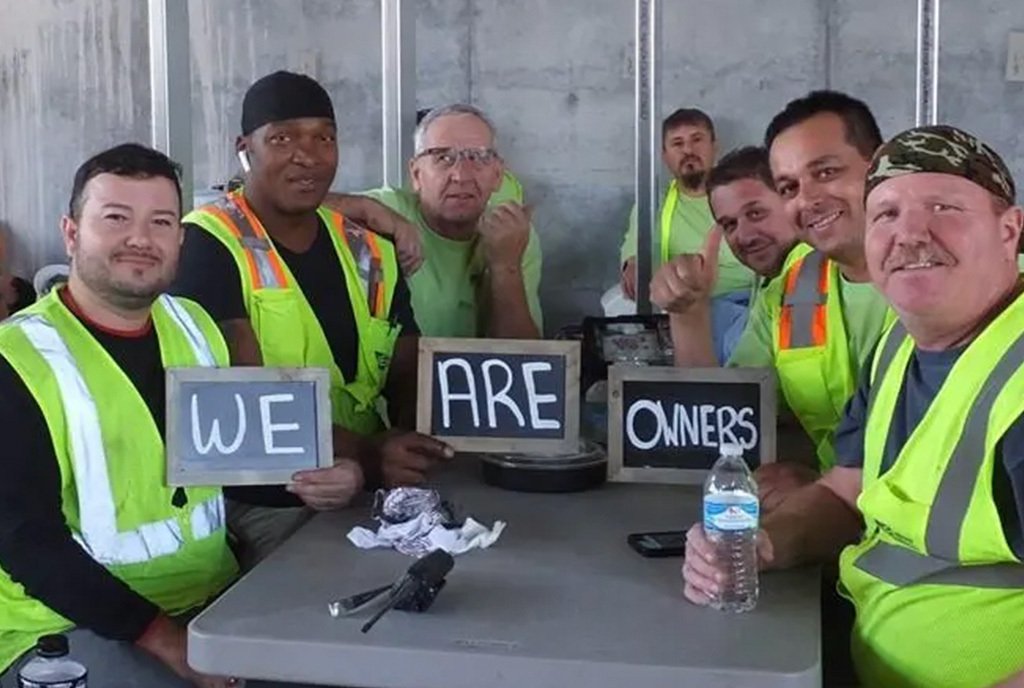

At NPQ, we have regularly explored the field of impact investing—that is, the use of investment capital for social benefit. We have also regularly examined the field of employee ownership. According to the latest estimates of the nonprofit National Center for Employee Ownership, an estimated 10.7 million Americans work today at what are known as employee stock ownership plan (ESOP) companies.
ESOPs are the most common form of employee ownership in the United States—and have been shown to greatly benefit workers of color. For instance, a 2019 study found that Latinx employee-owners in the sample had “12 times the wealth of the national median for Latinx households” while Black ESOP employees had “approximately three times the wealth of Black households nationally.” At least at the level of wealth building, employee ownership can be life changing.
So, for self-described impact investors, ESOPs—as well as other forms of employee ownership like worker cooperatives and employee ownership trusts—would seem to be a natural place to get considerable impact bang for your buck. But do impact investors realize this potential?
At least at the level of wealth building, employee ownership can be life changing.
Building on their previous study, published in November 2023, Curt Lyon and Julie Menter from Transform Finance run the numbers in their latest report. They find that there is both good news and bad news. The good news is that the amount of impact investing in employee ownership is rising rapidly. The bad news is that the level of investment remains frustratingly low.
Running the Numbers
As I wrote in NPQ over a year ago, when it comes to impact investing, how “impact” is defined matters a lot. Broadly speaking, and this reflects a considerably tightened definition of impact from US SIF (Forum for Sustainable and Responsible Investment), as of December 2022, an estimated $8.4 trillion of $66.6 trillion in total capital—or one dollar out of every eight dollars invested—is invested for social impact in some way.
How much is $8.4 trillion? Well, the population of the United States currently is about 336 million people, so that means $25,000 per person.
How much of that $8.4 trillion, however, makes it into supporting employee ownership? As you might imagine, considerably less. Using the broadest possible definition, Transform Finance identified 53 investment funds that invest all or part of their capital in employee ownership. In total, Lyon and Menter write, “these 53 funds have raised or are planning to raise $3.8 billion”—or a little less than five-hundredths of one percent of that mammoth $8.4 trillion. If, on the other hand, you look at funds that exclusively fund employee-owned businesses, numbers are still more modest—totaling 22 funds with $1.6 billion in assets under management. To use the same calculus as above, $1.6 billion works out to about $4.75 per person—in short, far less.
So, yes, employee ownership in impact investing is presently modest in scale. But it is growing considerably. For example, of the 53 funds analyzed, 28 of them have been created since 2018.
Most funds are also relatively small, but the fund size is increasing. According to the report, of the 42 funds where data are available, half (21) are small by standard investment industry standards—having less than $50 million in assets under management. But the other half are significantly larger: 7 have between $50 and $100 million in assets, 8 have between $100 million and $250 million, and 6 have over $250 million in assets.
Of the 53 funds analyzed, 28 of them have been created since 2018.
The growth in both the number of funds and assets under management is important because it means that when business owners are set to retire and want to sell their firm to their employees, it is far easier if a fund is involved in the transaction to enable the owner to get their money out more rapidly. This, in turn, makes it far more likely that owners will be willing to sell their firms to their employees.
Absent fund involvement, the typical way conversion to employee ownership occurs relies on what is known as “seller financing”—in other words, the selling owners allow the employees to borrow from them, meaning the owners don’t get all their money in the sale until the loan is paid off, a process that can take several years. Writing for NPQ, Todd Leverette of Apis & Heritage Capital Partners, one of the 53 funds examined in the report, estimated that getting a seller-financed loan fully paid off can often involve a “seven-to-10-year process.”
Sign up for our free newsletters
Subscribe to NPQ's newsletters to have our top stories delivered directly to your inbox.
By signing up, you agree to our privacy policy and terms of use, and to receive messages from NPQ and our partners.
Employee ownership funds, Lyon and Menter add, play many roles in addition to providing capital. These include “sourcing deals, working with the business owners to structure the transaction, securing any additional capital needed to execute the deal, and even providing technical assistance after the transaction to embed an ownership culture at the newly employee-owned business.”
Variations in Strategy
When business owners are set to retire and want to sell their firm to their employees, it is far easier if a fund is involved.
In their report, Lyon and Menter offer a breakdown of employee ownership strategy.
ESOPs, the most common form of employee ownership in the United States, are, they note, “very well suited for building wealth for employees.” Their weaknesses, they add, are that ESOPs can be sold—it’s not uncommon for an employee-owned business to cash out, which is good for the employees (often), but means that future employees don’t benefit from employee ownership. ESOPs are also typically not democratically managed (although they can be if the ESOP is structured as such).
According to Lyon and Menter, worker cooperatives, which are growing in number rapidly, create wealth less quickly, but they are very effective at building worker power, are deeply democratic, and—unlike ESOPs—are rarely sold to non-employee-owners. If profitable, they also offer annual “patronage dividends” to their member-owners—a form of profit distribution.
Employee ownership trusts, Lyon and Menter note, share some aspects with worker cooperatives, such as annual profit distribution. They also include legal mechanisms that prohibit sale. However, in a trust, workers do not “own” the company (the trust does). This means they tend to build less wealth for workers than ESOPs.
Different funds, they note, may opt to specialize in one of these models—or, sometimes, invest in supporting multiple forms of worker ownership.
How to Deepen Impact
In their report, Lyon and Menter note that there are at least five potential dimensions of impact for employee ownership—economic benefits, governance rights, protection of non-economic mission (such as environmental sustainability), benefits to marginalized communities and communities of color, and integration with broader movements, such as the solidarity economy.
More broadly, they also offer some suggestions to impact investors about how to make investing in employee ownership more impactful. Among their recommendations:
- Commit capital early
- Support fund managers of color in an industry where people of color are vastly underrepresented, with a 2024 Harvard Study finding that White males oversee an astonishing 98.6 percent of total assets under management.
- Consider an integrated capital stack that combines investments with grants
- Partner with community development financial institutions (CDFIs)
- Support policy advocacy and field building, including supporting networks of peer advisors
For years, the mantra in the employee ownership field has been to address the “silver tsunami”—the wave of over two million small-business owners from the baby boom generation who employ over 24 million people, many of whom have no ready heirs to take over their businesses. Employee ownership has long seemed like an obvious solution that could both help ensure the continuation of existing businesses and promote a more equitable distribution of wealth and business assets in the process.
But as Leverette wisely observed two years ago: “Without concerted efforts by both old and new economic actors in both the philanthropic and private sectors, the chance that employee-owned businesses will lead to a paradigm shift in the US economy remains small. Crises create opportunities for change, but they don’t guarantee it.”
For those interested in learning more and hearing directly from the authors of the report, Transform Finance is hosting a free webinar on August 20 at 12:00 pm EST. Free registration is available here.











